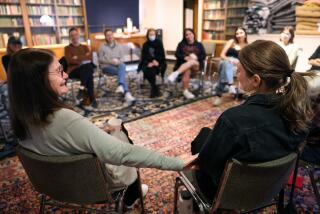‘This Is a Place That Time Has Forgotten’ : ‘Colony’ May Thrust Lepers Into Bright Light of 20th Century
- Share via
CARVILLE, La. — The cemetery marker identifies those who have died here by number, and sometimes by a nickname: “Teddy” or “Mrs. D.” or “B.J.”
The shame of leprosy has robbed them of their names even on the roster of death.
The lepers came here to hide or be hidden. Some came years ago in shackles, exiled by law. Others, more recently, came by choice to this institution for the treatment of Hansen’s disease, or leprosy.
It is time to end the hiding, the director of the facility says. No new patient will be allowed to live here. He has proposed that most of the work of the federal institution be moved to Baton Rouge, and that patients be treated where they live.
“We are probably the last nation on Earth to still maintain a colony for leprosy,” said the director, Dr. John C. Duffy. “This is a place that time has forgotten. It lives in the past.
“If anything, a colony like this is a disgrace,” he said.
Decentralizing Treatment
Duffy calls his plan for the Gillis W. Long Hansen’s Disease Center a “restructuring,” not a closing. About 130 resident patients will be allowed to stay, under care reduced to about the level of a nursing home. A study to determine the cost of moving the other departments 35 miles to Baton Rouge must be finished before the plan is complete.
Duffy said he believes that the end has come to this chapter in the treatment of the biblical scourge. The disease has been so feared because of the leper’s appearance. The slow-moving bacteria attack nerves in the cool extremities of the body--the hands, feet, nose and ears. With the loss of sensation, unfelt injuries and eventual bone deterioration, a patient often looks scarred and grotesque.
Isolation is not needed now, and never really was, Duffy said. Even untreated leprosy is difficult to transmit to others, and within a week of beginning medication, progress of the disease is arrested and a patient becomes non-contagious.
“Everything you see here is an anachronism. It is not today. It’s yesterday. It does not reflect the current knowledge about Hansen’s disease,” Duffy said.
Rita Donaldson knows of the yesterdays. Her father brought her here 61 years ago, when she was 21. Without a word, he left her on the front steps, her disfigured face hidden under the wide brim of a hat. She never saw him again. Now she sees no one.
“I asked and pleaded with my brothers when I started to go blind, to let me see my father one more time. They wouldn’t let me back in the house,” she said. “I wrote them letters and said ‘I’m human, too.’ ” Her letters were sterilized before they were mailed.
When her ailment was diagnosed as Hansen’s disease, the law in Louisiana and many other states required that she be sent away to the nation’s only place for lepers. A boyfriend, the same beau who had written her soulful love letters, turned her in to the authorities when the red bumps appeared on her face. Her family was ordered to send her away.
“My father wanted to take me away from my brothers and sisters,” she said. “All the people were already scared to come to our house.”
She tells this with a sort of bemusement that has grown, like the callouses on her body, over the years. Her hands have been crippled by the disease, her face disfigured, her feet numbed. She curls up in an oversized chair in her room, wearing outrageous sunglasses and an irrepressible spirit. A radio is in her lap, tuned for the next game of her passion, the Houston Astros.
“This is my home, whether I like it or not,” she says of the Carville facility.
Disease Subdued, Not Extinguished
Leprosy still thrives in the world and lingers in the United States. Medicine has learned to subdue, but not extinguish it. Treatment begun early enough can arrest the disfigurement that has long been its mark.
So effective is modern treatment that most of the estimated 6,000 lepers in the United States are under care of their own doctors or clinics near home. Their friends and neighbors probably do not know of their disease, and need not know, since there is no danger of catching it.
But the fear remains. “I thought, ‘Oh my God, why me? I thought my life was over,’ ” a 40-year-old executive said of his reaction to the diagnosis.
He went to a doctor when he had trouble straightening the fingers of his left hand. Buttoning his shirt was hard; picking up a coffee cup was risky. He could not feel pain when hot ashes from his cigarette brushed his hand.
“You have read books and seen pictures, and you think the worst,” he said. “My first concern when I found out is whether I am going to pass this along to my family, to my colleagues.”
He came to the Hansen’s Disease Center for evaluation. Surgery will straighten his hand and the drugs will arrest the disease. He has a letter from the doctors stating that he poses no danger to others, and he is debating whether to give it to his superiors at his company.
“I’d like to be honest with them, but I don’t know what they will do.” He does not want to give his name or identify his employer, a Fortune 500 company.
“There is such a history of stigma to this disease,” said Sister Francis de Sales, one of nine Roman Catholic nuns who serves at the center. She handles admission records, and “of the last 10 (new patients), three of them wept through the entire admitting procedure.”
She was 14, a Wisconsin schoolgirl on a prayer retreat, when she decided to be a nun and to help lepers, Sister Frances said. When she first came to Carville in 1942, she said, “I thought this was the end. I thought God sent me here, and I would never be allowed to leave.”
Now 73, she has remained here since, except for seven years spent in Paris by her choice. “I’ve been happy ever since. I think this (work) is like falling in love, it’s something forceful in you.”
She walked a path of courage forged by others in her order, the Daughters of Charity of St. Vincent de Paul, based in Emmitsburg, Md. Four of its sisters traveled to the isolated sugar cane plantation in 1896 to care for lepers who were living in slave shacks.
The lepers had been brought two years earlier from a squalid “pest house” in New Orleans after the Daily-Picayune newspaper exposed conditions in the city. The state leased the plantation under the pretense of starting an ostrich farm and brought to it five men and two women in a coal barge. It was meant as humane treatment.
Improvements at Carville were slow in coming. Lepers arriving at the Kalaupapa colony on the Hawaiian island of Molokai were thrown onto the beach from boats, and Carville was populated by sick people transported under guard, sometimes in sealed boxcars. The federal Public Health Service took over the facility in 1921.
Treatable Since 1940s
The sulfone drugs that arrest the disease were developed at Carville in 1941, but well into the 1960s, many states still had laws requiring that anyone with the disease be sent away to Carville.
Even today, the isolation persists. Neighbors here are the back-alley fixtures of society: a state prison, some uncomplaining cows and foul-smelling chemical factories. An 8-foot-high chain-link fence rings the premises and there is a manned guard post at the front.
Many of the more recent patients are immigrants from Third World countries. There are an estimated 12 million cases worldwide. No one is certain how the disease spreads, but it is prevalent in Asia, central Africa, India and South America where poverty rules and medical care is poor.
Of 191 patients at the center now, 98 are Latino and 35 are Asian.
Carville has a worldwide reputation, both for its care and its scientific research. Duffy’s proposal to dismantle the institution has had and explosive impact with the staff.
Dr. John R. Trautman, who was director at Carville for 18 years and is now chief of international programs, said: “It is not my call to make,” but “ . . . closing this would be disastrous. The rest of the world is looking at this facility to help rid themselves of this disease.”
Dissent on Moving
Dr. Robert Hastings, who oversees the labyrinth of research labs and the 270 armadillos used in testing for the disease, said he believes that moving would destroy the “unique thing about this place,” the proximity of the research work to the patients and those who care for them.
Duffy, who took over 17 months ago at the appointment of U.S. Surgeon General C. Everett Koop, was blunt in his rebuttal. “When I came here I found a facility in suspended animation, going nowhere, with no sense of the future.
“This is a staff that hasn’t had a bright idea in 50 years,” he said.
Duffy believes that research could better be done on a university campus, and patients could be treated more easily in a city. “The swamps by the Mississippi are not where to do modern research and treatment of a modern disease,” he said.
Younger patients--there are 31 who are under age 50--should be required to leave the center and be treated as outpatients, he said.
“It’s a tough world out there. You have to make a living and take a job,” he said. “They are owed treatment for their disease (but) I don’t think the American people think they are owed a complete life-support system.”
The older patients were promised they will be allowed to stay at Carville, Duffy said.
“There are 120 or 130 (patients) who have been put here by the federal government. We have taken away their personal support systems, robbed them of their identities, put them in a total state of dependency,” he said. “They will be able to stay here until they die.”
More to Read
Sign up for Essential California
The most important California stories and recommendations in your inbox every morning.
You may occasionally receive promotional content from the Los Angeles Times.











